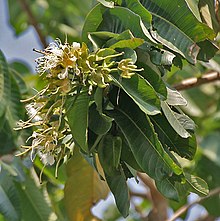Duabanga grandiflora
| Duabanga grandiflora | |
|---|---|

| |
| Scientific classification | |
| Kingdom: | Plantae |
| Clade: | Tracheophytes |
| Clade: | Angiosperms |
| Clade: | Eudicots |
| Clade: | Rosids |
| Order: | Myrtales |
| Family: | Lythraceae |
| Genus: | Duabanga |
| Species: | D. grandiflora
|
| Binomial name | |
| Duabanga grandiflora | |

From its peculiar habit, Duabanga grandiflora (syn. D. sonneratioides) is a singular feature in its native forests. The trunk is erect, 40–80 feet high, undivided but sometimes forking from the base. The lower limbs spread drooping from the trunk; these are long, slender, sparingly branched, and the branches are four-angled, loosely covered with large spreading leaves. Since the leaves are arranged in two ranks, the slender branches resemble petioles, bearing pinnae of a compound leaf; the leaves are further often recurved, and are deep green above, and almost white beneath. The large blossoms expand in April, exhaling a rank odour reportedly resembling asafoetida when they first burst, but they become inodorous before the petals drop. The stamens are all bent inwards in bud. The fruit is a large as a small apple. The wood is white and soft.[1]
Distribution[]
Native to India, Nepal, southern China, Myanmar and Malaysia.[2]
Gallery[]

trunk at Jayanti in Buxa Tiger Reserve in Jalpaiguri district of West Bengal, India.

middle story at Jayanti in Buxa Tiger Reserve in Jalpaiguri district of West Bengal, India.

at Jayanti in Buxa Tiger Reserve in Jalpaiguri district of West Bengal, India.

leaves at Jayanti in Buxa Tiger Reserve in Jalpaiguri district of West Bengal, India.
References[]
- ^ Hooker p.56
- ^ "Duabanga grandiflora in Annotated Checklist of the Flowering Plants of Nepal @ efloras.org". www.efloras.org. Retrieved 2019-05-09.
- Hooker, Joseph Dalton; J. F. Cathcart; W. H. Fitch (1855). Illustrations of Himalayan plants. London: L. Reeve. pp. 55–56. LCC QK349.33 .H66 1855.
- Duabanga
- Myrtales stubs
- Trees of India
- Trees of Nepal



